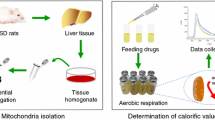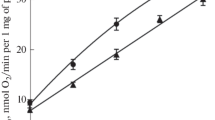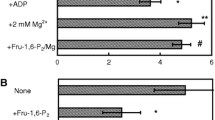Summary
Alloxan inhibited aconitase with a half maximal inhibitory concentration of 0.5 mM in sonically disrupted and 2.3 mM in intact isolated liver mitochondria. For dialuric acid the half maximal inhibitory concentrations were 1.1 mM and 2.5 mM, respectively. Ninhydrin and N-ethylmaleimide (NEM) also inhibited aconitase with half maximal inhibitory concentrations in the submillimolar range and t-butylhydroperoxide (BuOOH) in the millimolar range, which, however, were not different for disrupted and intact mitochondria. Only the aconitase substrate citrate, but not glucose provided protection of the enzyme against inhibition. In intact liver cells the half maximal inhibitory concentration for alloxan was 6.8 mM. Again, dialuric acid and BuOOH were less potent inhibitors while ninhydrin and NEM were more potent inhibitors of aconitase in intact liver cells. In intact liver cells, glucose and 3-O-methylglucose, but not mannoheptulose and citrate provided protection against alloxan inhibition. The results show that aconitase is not an enzyme particularly sensitive towards alloxan inhibition and thus apparently not a primary site for mediation of alloxan toxicity as it is the glucokinase. This makes a primary site of alloxan action in the mitochondria extremely unlikely. On the other hand the results demonstrate that both the intact mitochondrial and plasma membrane as uptake barriers provide protection against alloxan toxicity. In addition the results clearly show, that 3-O-methylglucose provides protection against alloxan action only at the level of the plasma membrane through inhibition of alloxan uptake into the cell, while the site of protection of mannoheptulose is only the sugar binding site of the glucokinase. In contrast, glucose is shown here to be the only sugar with a dual protective effect both through inhibition of alloxan uptake through the plasma membrane like 3-0methylglucose and through protection of the glucokinase sugar binding site against alloxan inhibition of the en zyme like mannoheptulose. In the light of these results the unique protective potency of glucose as compared to that of other sugars is not surprising.
Similar content being viewed by others
References
Beinert H, Thomson AJ (1983) Three-iron clusters in iron-sulfur proteins. Arch Biochem Biophys 222:333–361
Bell GI, Kayano T, Buse JB, Burant CF, Takeda J, Lin D, Fukumoto H, Seino S (1990) Molecular biology of mammalian glucose transporters. Diabetes Care 13:198–208
Biltz H, Damm P (1913) Über die Gewinnung von Dialursäuren und Uramilen. Ber Dtsch Chem Ges 46:3662–3673
Boquist L, Boström T (1985) Alloxan effects on mitrochondria in vitro, studies with regard to inhibition of mitochondrial aconitase. Diab Metab 11:232–237
Boquist L, Ericsson I (1984) Inhibition by alloxan of mitochondria aconitase and other enzymes associated with the citric acid cycle. Febs Lett 178:245–248
Boquist L, Nelson L, Lorentson R (1983) Uptake of labeled alloxan in mouse organs and mitochondria in vivo and in vitro. Endocrinology 113:943–948
Cooperstein SJ, Watkins D (1981) Action of toxic drugs on islet cells. In: Cooperstein SJ, Watkins D (eds) The islets of Langerhans. Academic Press, New York, pp 387–425
Gawron O, Waheed A, Glaid AJ, Jaklitsch A (1974) Iron and aconitase activity. Biochem J 139:709–714
Glukser JP (1971) Aconitase. In: Boyer PD (ed) The enzymes, vol 5. Academic Press, New York, London, pp 413–439
Johnson PG, Waheed A, Jones L, Glaid AJ, Gawron O (1977) Identification of an essential residue of pig heart aconitase. Biochem Biophys Res Commun 74:384–389
Kennedy MC, Emptage MH, Dreyer J-L, Beinert H (1983) The role of iron in the activation-inactivation of aconitase. J Biol Chem 258:11098–11105
Kennedy MC, Spoto G, Emptage MH, Beinert H (1988) The active site sulfhydryl of aconitase is not required for the catalytic activity. J Biol Chem 263:8190–8193
Kent TA, Emptage MH, Merkle H, Kennedy MC, Beinert H, Münck E (1985) Mössbauer studies of aconitase. Substrate and inhibitor binding, reaction intermediates, and hyperfine interac tions of reduced 3Fe and 4Fe clusters. J Biol Chem 260:6871–6881
Lenzen S (1979) Insulin secretion by isolated perfused rat and mouse pancreas. Am J Physiol 236:E391-E400
Lenzen S (1992) Glucokinase: signal recognition enzyme in pancreatic B-cells for glucose-induced insulin secretion. In: Flatt PR (ed) Nutrient regulation of insulin secretion. Portland Press, London Chapel Hill, pp 101–124
Lenzen S, Munday R (1991) Thiol-group reactivity, hydrophilicity and stability of alloxan, its reduction products and its N-methyl derivatives and a comparison with ninhydrin. Biochem Pharmacol 42:1385–1391
Lenzen S, Panten U (1988a) Signal recognition by pancreatic B-cells. Biochem Pharmacol 37:371–378
Lenzen S, Panten U (1988b) Alloxan: history and mechanism of action. Diabetologia 31:337–342
Lenzen S, Schmidt W, Panten U (1985) Transamination of neutral amino acids and 2-keto acids in pancreatic B-cell mitrochondria. J Biol Chem 260:12629–12634
Lenzen S, Tiedge M, Panten U (1987) Glucokinase in pancreatic B-cells and its inhibition by alloxan. Acta Endocrinol 115:21–29
Lenzen S, Brand F-H, Panten U (1988a) Structural requirements of alloxan and ninhydrin for glucokinase inhibition and of glucose for protection against inhibition. Br J Pharmacol 95:851–859
Lenzen S, Freytag S, Panten U (1988b) Inhibition of glucokinase by alloxan through interaction with SH groups in the sugar-binding site of the enzyme. Mol Pharmacol 34:395–400
Lenzen S, Freytag S, Panten U, Flatt PR, Bailey CJ (1990) Alloxan inhibition of hexokinase from normal and tumoural pancreatic islet cells. Pharmacol Toxicol 66:157–162
Malaisse-Lagae F, Sener A, Malaisse WJ (1983) Contrasting modes of action of D-glucose and 3-O-methyl-D-glucose as protectors of the rat pancreatic B-cell against alloxan. Biochim Biophys Acta 762:36–43
McDaniel M, Roth C, Fink J, Fyfe G, Lacy P (1975) Effects of cytochalasins B and D on alloxan inhibition of insulin release. Biochem Biophys Res Commun 66:1089–1096
McKnight GS (1977) A colorimetric method for the determination of submicrogram quantities of protein. Anal Biochem 78:86–92
Miwa I, Hara H, Okuda J (1986) Parallel inhibition of islet glucokinase and glucose-stimulated insulin secretion by either alloxan or ninhydrin. J Clin Biochem Nutr 1:237–245
Miwa I, Hara H, Okuda J, Matsunaga H, Ogawa S (1984) Inhibition of glucokinase in hepatocytes by alloxan. Biochem Int 9:595–602
Munday R (1988) Dialuric acid autoxidation. Effects of transition metals on the reaction rate and on the generation of “active oxygen” species. Biochem Pharmacol 37:409–413
Plank DW, Howard JB (1988) Identification of the reactive sulfhydryl and sequences of cysteinyl-tryptic peptides from beef heart aconitase. J Biol Chem 263:8184–8189
Robinson JB, Srere PA (1985) Organization of Krebs tricarboxylic acid cycle enzymes in mitrochondria. J Biol Chem 260:10800–10805
Rose IA, O'Connell EL (1967) Mechanism of aconitase action. I. The hydrogen transfer reaction. J Biol Chem 242:1870–1879
Seglen PO (1973) Preparation of rat liver cells. 3. Enzymatic requirements for tissue dispersion. Exp Cell Res 82:391–398
Tomita T, Kobayashi M (1976) Differential effect of alpha- and beta-D-glucose on protection against alloxan toxicity in isolated islets. Biochem Biophys Res Commun 73:791–798
Weaver DC, McDaniel ML, Lacy PE (1978) Alloxan uptake by isolated rat islets of Langerhans. Endocrinology 102:1847–1855
Winterbourn CC, Cowden WB, Sutton HC (1989) Auto-oxidation of dialuric acid, divicine and isouramil. Superoxide dependent and independent mechanisms. Biochem Pharmacol 38:611–618
Winterbourn CC, Munday R (1989) Glutathione-mediated redox cycling of alloxan. Mechanisms of superoxide dismutase inhibition and of metal-catalysed OH formation. Biochem Pharmacol 38:271–277
Author information
Authors and Affiliations
Rights and permissions
About this article
Cite this article
Lenzen, S., Mirzaie-Petri, M. Inhibition of aconitase by alloxan and the differential modes of protection of glucose, 3-O-methylglucose, and mannoheptulose. Naunyn-Schmiedeberg's Arch Pharmacol 346, 532–536 (1992). https://doi.org/10.1007/BF00169009
Received:
Accepted:
Issue Date:
DOI: https://doi.org/10.1007/BF00169009




